-
生物炭(biochar,BC)是生物质在限氧条件下热解(<700 ℃)形成的固态的、难熔的、高度芳香化的富含碳的材料[1],被广泛用于固碳[1-2]、土壤改良[3-4]、水体和土壤污染修复[5]等领域. 溶解性黑碳(dissolved black carbon,DBC)是BC中可溶于水的具有稠环芳烃结构的组分[6]. BC的大规模施用导致DBC释放[7],并通过灌溉、渗透、地表径流在环境中迁移[8]. 相比于BC,DBC具有较小的芳香微域结构和更多的羧基和羟基官能团[8-9],有更高的反应活性和更强的环境迁移能力[9]. 据估计,DBC全球河流通量每年可达2650万t,占河流进入海洋溶解有机碳通量的10%,是陆地BC输入海洋的一个重要来源[6, 10]. DBC的芳香微域结构是有机物和重金属吸附/络合的高能位点[9],会影响污染物的吸附、迁移、转化等关键环境过程[8]. DBC富含的羧基和羟基官能团是其在氧化-还原反应中的重要电子来源[8],参与有机污染物的光化学转化过程[10-11]. 原料和热解温度(heating temperature,HTT)是影响BC性质和用途的关键因素,也必然决定了DBC的结构特征和环境行为[12]. 研究发现,木质素含量较高的稻壳制备的BC芳香性和产量显著高于低木质素含量的甘蔗所制备的BC[3]. 另外,相比于低温(<500 ℃)制备的BC,高温(>500 ℃)BC往往具有更高的芳香性、灰分和pH[5]. 因此,深入理解水环境中不同原料和HTT的DBC与有机污染物的相互作用,有助于更好地预测BC施用环境中污染物的环境行为和评估污染物的生态风险.
光化学转化是影响水环境中有机污染物环境归趋的重要过程[13]. 水环境中光敏剂的分子结构(芳香性结构和分子大小)和环境条件(pH和盐离子)等是影响光降解的重要因素[14]. 与水环境中天然溶解有机质(natural organic matter,NOM)相比,人工来源的DBC稠环度高,芳香性强,分子量较小,这使其具有更高的光电转化效率[8, 15],更易产生羟基自由基(·OH)、单线态氧(1O2)和激发三重态DBC(3DBC*)等活性中间体(reactive intermediates,RIS)[10]. DBC的这些特性导致其对水环境中有机污染物的光降解过程的影响较NOM更为复杂[16]. 研究发现,DBC促进了塑化剂(如邻苯二甲酸二乙酯)[16]、杀虫剂(如吡虫啉)[12]、个人护理品(如阿替洛尔)[15]和性激素(如17-β雌二醇)[10]等多种有机污染物的光降解. 然而,腐殖酸(humic acid, HA)(DBC的重要组成部分)也可能会因遮光效应抑制有机物的光降解[13]. 可见,DBC参与的水环境中有机污染物的降解过程仍然存在不确定性.
新污染物是指由人类活动造成的,但尚无法律法规和标准规定或规定不完善的,危害人体健康和生态环境的污染物,主要包括环境内分泌干扰物、全氟化合物、微塑料和抗生素(antibiotics, ATs)四大类[17],而我国对于新污染物的毒理学风险评估、替代技术开发的方面还有局限性. ATs是一类由微生物分泌、化学合成或半合成的化合物,因其对微生物生长代谢的抑制而被广泛应用于医疗、畜牧业、水产养殖等领域[18]. 四环素(tetracycline, TC)因其广谱抗菌性和低廉的价格成为使用量最大的ATs之一. 2015年,全球TC使用量达6万t[19],这也导致TC在地表水、地下水和饮用水等水环境中被广泛检出,含量为ng·L−1—μg·L−1[20-21]. TC对水生动物(水生植物、浮游动物和鱼类)具有较强的生物急性毒性,能够抑制藻类和水生植物叶绿素的合成[22-23]、促进氧化应激反应的产生,影响浮游动物和鱼类的生长发育[22],同时TC还能够破坏水体微生物群落结构[21],损害水生生态系统的结构和功能[24]. 另外,ATs的长期暴露能够促进抗生素抗性基因的传播扩散,增加人体对ATs的抗药性[25],对人体健康产生极大的威胁[18, 26]. ATs在水环境中的光降解过程引起了广泛关注[13]. ATs的光降解主要受ATs种类[15]、环境条件(pH、盐离子)[27]、光敏剂(NOM、DBC)[10]等影响. 目前,水环境中DBC存在时,ATs的光降解研究以往主要集中在单一HTT制备的DBC对ATs光降解的影响上[13, 28],很少涉及不同原料和HTT的DBC对TC光降解的影响.
本研究以不同HTT(300—600 ºC)制备的湿地植物芦苇(Phragmites australis)和芦竹(Arundo donax)BC为原料提取DBC,探究HTT对DBC理化性质及结构特征的影响,系统研究了不同HTT的DBC对水环境中典型ATs TC的光降解的影响,并探讨了水中常见离子和pH对TC光降解过程的影响,以期阐明DBC影响TC光降解的主要机制. 研究结果将为评估DBC的环境行为及其对共存有机污染物的环境归趋的预测和生态风险的评估提供理论依据.
-
本研究所用BC均是实验室前期以湿地植物芦苇和芦竹为原料,利用限氧慢速热解法在300—600 ℃条件下制备[29]. DBC的提取步骤如下[10, 13]:将0.2 g BC置于20 mL超纯水中,室温条件下130 r·min−1振荡12 h,过0.45 μm醋酸纤维膜,收集滤液. 将滤膜上的BC重新分散在20 mL超纯水中,用水浴超声仪(KQ-500DE,昆山舒美,中国)在40 kHz频率下水浴超声30 min,过0.45 μm醋酸纤维膜后再次收集滤液. 重复上述超声提取过程两次,合并收集到的滤液,即为DBC溶液[10, 15]. 芦苇DBC标记为LW300、LW400和LW500,芦竹DBC标记为LZ300、LZ400、LZ500和LZ600,数字代表BC的HTT. 将DBC置于4 ℃冰箱中避光保存. TC(纯度>99%)购于生工生物工程(上海)股份有限公司,理化性质见表1.
-
总有机碳分析仪(TOC-Vcpn,Shimadzu,日本)和pH计(AB150,Thermo Fisher Scientific,美国)测定DBC的总有机碳(TOC)含量和pH. 紫外可见分光光度计(UV-9000S,上海元析,中国)测定DBC紫外-可见吸收光谱,扫描波长为100—900 nm. 荧光分光光度计(F-4600,日立,日本)分析DBC的荧光特性,测定发射波长(Em)为200—550 nm,激发波长(Ex)为220—450 nm. 傅里叶变换红外光谱仪(FTIR,Spectrum Two,PerkinElmer,英国)测定DBC的官能团,扫描区域为4000—500 cm−1,分辨率 4 cm−1 .
-
在模拟太阳光照射下,于100 mL石英管(含20 mL溶液)中进行DBC暴露下的TC光解实验[27]. 以测得TOC作为DBC原始质量浓度(表2),配置100 mg·L−1(以C的质量计)的DBC储备液. 向石英管中分别加入0.02、0.2、2 mL的DBC储备液和1 mL的TC储备液(400 mg·L−1),用超纯水定容至20 mL. 将石英管放在于以汞灯为光源的光化学反应仪(BL-GHX-V,上海比朗,中国)中,波长为290—400 nm,光功率密度为30 W·m−2,石英管以25 r·min−1匀速旋转. 反应启动后,分别在0、10、20、40、60 min时取600 µL反应溶液,过0.22 µm聚醚砜滤膜后用高效液相色谱仪(HPLC 1260,安捷伦,美国)对TC定量分析. HPLC的检测条件为:C18反向色谱柱(3.5 μm,4.6 mm×250 mm),紫外检测器,波长设为355 nm,柱温为30 ℃,流动相为1:3的乙腈和草酸(0.01 mol·L−1)溶液,流速为 1 mL·min−1,进样量为20 μL.
-
向含有2 mL DBC储备液的石英管中分别加入0、0.25、0.5、1、2 mL的TC储备液,用超纯水定容至20 mL,按照1.3.1节中条件光解、检测.
-
选择水环境中常见的阴离子(NO3−、HCO3−、SO42-、Cl−)和阳离子(Fe3+、Ca2+)进行光解实验[27]. 向含有2 mL DBC储备液和1 mL TC储备液的石英管中分别加入0、0.002、0.02、0.2、2 mL的离子储备液(100 mg·L−1),用超纯水定容至20 mL,按照1.3.1节中条件光解、检测.
-
使用0.1 mol·L−1的HCl和NaOH将含有DBC(10 mg·L−1)和TC(20 mg·L−1)混合溶液的pH分别调整为3、5、7、9和11. 按照1.3.1节中条件光解、检测.
-
为确定DBC产生的不同RIS在TC光降解中的作用,选择常用的猝灭剂异丙醇(IPA)、2,4,6-三甲基酚(TMP)和叠氮化钠(NaN3)分别验证·OH、3DBC*以及·OH和1O2在光降解过程中的作用[10, 12]. 向含有2 mL DBC储备液和1 mL TC储备液的石英管中分别添加20 μL IPA、2 mL 80 mg·L−1的NaN3和2 mL 0.545 g·L−1的TMP,用超纯水定容至20 mL,按照1.3.1节中条件光解、检测.
-
采用Excel 2016和Origin 2018进行实验结果的处理分析及图表绘制. 使用SPSS 22.0进行单因素方差分析(ANOVA),结合Duncan 检验(P < 0.05)进行显著性差异分析. 利用Origin 2018绘制三维荧光光谱图并对荧光区域积分进行定量分析. 用二级动力学模型(1/C-1/C0=kt)模拟TC光降解动力学[13],其中C和C0分别是t时刻和0时刻的TC浓度,k是二级速率常数.
-
DBC的物理化学性质如表2所示. 随着HTT升高,芦苇和芦竹DBC的TOC含量均呈先升高后降低的趋势. 这是由于在较低HTT下(300—400 ℃),BC炭化程度低,溶解性物质含量较高[3, 30];当HTT升至500 ℃时,纤维素和木质素进一步分解聚合,产生更多稳定性较强的芳烃类物质[3]. 另外,芦竹DBC的TOC含量(101—832 mg·L−1)高于芦苇DBC(98.9—152 mg·L−1),这可能是芦竹生物质较芦苇含有更多的纤维素和半纤维素[31],导致相同HTT的芦竹BC稳定性较低,含有更多的可溶性物质. 随着HTT升高,芦苇和芦竹DBC的pH分别由4.25和5.66上升至5.96和10.2,这是因为HTT升高导致BC中矿物质富集,且矿物质的溶解使得DBC的溶液的pH增加[3]. E4/E6是有机质的芳香性指标,与芳香性呈反比[12]. 随着HTT的升高,芦苇和芦竹DBC的E4/E6由7.17和5.48降低至3.88和2.00(除LZ400外),说明高HTT的DBC芳香性更高. 这是因为BC形成时,生物质发生脱水和裂解反应导致不稳定有机物分解,而聚合反应增加了芳香性物质的含量[5]. 值得注意的是,LZ400的E4/E6大幅升高,这可能是因为纤维素分解为酸醛等可溶性高的物质[32],导致芳香性组分在水相总有机质中占比下降. SUVA254是有机质的芳香性指标,与芳香性呈正比[12]. 随着HTT升高SUVA254先降低后升高,这表明芳香性在400 ℃时降低,但高温DBC芳香性更高这与E4/E6的结果一致. 相同HTT下,芦苇DBC(0.12—0.18 L·(mg·C·m-1)−1)比芦竹DBC(0.02—0.17 L·(mg·C·m-1)−1)的芳香性更强,这可能是由于芦苇生物质的木质素含量高,产生的BC芳香性物质更多[31]. E2/E3是有机质分子量大小的指标,与其分子量呈反比[12]. 两类DBC的E2/E3随HTT增加先升高后降低,表明DBC分子量先降低后上升,这与芦苇和芦竹热解形成BC的过程中脂肪烃分解和芳香烃的形成有关[30]. 另外,相同HTT下,芦竹DBC的E2/E3比值(3.81—7.28)高于芦苇DBC(3.67—5.01),表明芦竹DBC平均分子量更小,这与TOC的含量变化规律一致,表明小分子量物质可能更易从BC溶出,形成DBC[33].
DBC的FTIR图谱如图1所示. 对于芦竹DBC,其在1495—1734 cm−1(C=C、C=O)、1405 cm−1(—CH2—)和1159 cm−1(C—O)处有明显的吸收峰[34].
随着HTT的升高,C—O的峰大幅度降低,—CH2—的峰也变小,表明不稳定的脂肪族化合物逐渐被分解,而C=C和C=O虽有小幅度降低,但仍有较大的振动峰存在,表明芦竹DBC仍具有较高的芳香性组分[34]. 对于芦苇DBC,在3338 cm−1(酚羟基,—OH)[29, 35]、1495—1734 cm−1(C=C、C=O)、1405 cm−1(—CH2—)和1159 cm−1(C—O)处有明显的吸收峰. 随着HTT升高,—CH2—和C—O的峰逐渐消失,表明不稳定的脂肪烃逐渐分解,C=C和C=O的峰虽也消失,但酚—OH的峰却无明显变化,说明芦苇DBC中的芳香性组分虽有分解,但仍有较高含量的芳香性组分存在. 总体来说,随着HTT的升高,DBC中脂肪族化合物的含量降低,芳香性组分含量增加,这与DBC的芳香性增加的结果一致(表2).
DBC发色基团的含量对于其光化学反应的发生至关重要[36]. 因此对DBC进行了三维荧光光谱(3D-EEM)分析(图2).
LW300、LW400、LZ300、LZ400和LZ500在Ⅲ(Ex:200—250 nm和Em:380—550 nm)、Ⅳ(Ex: 200—250 nm和Em: 330—380 nm)和Ⅴ(Ex: 250—400 nm和Em: 380—550 nm)处有明显的荧光峰,它们分别代表富里酸(fulvic acid, FA)类、溶解性微生物代谢产物和HA类物质. LW500和LZ600仅在Ⅲ和Ⅴ处有荧光峰,表明存在FA类和HA类物质. 所有DBC在Ⅰ(Ex:200—250 nm和Em:280—330 nm)和Ⅱ(Ex:200—250 nm和Em:330—380 nm)区域的荧光峰不明显,表明存在芳香性类蛋白质物质. 这些结果表明FA类和HA类物质是DBC的主要组分. 随HTT升高,芦苇DBC FA和HA相对含量分别由21.9%和49.7%增加至24.9%和63.6%,溶解性微生物代谢产物含量由17.1%降至7.5%,芦竹DBCFA类含量由15.6%增加到26.6%,溶解性微生物代谢产物和HA的含量分别由59.3%和18.2%减少到56.4%和9.7%. FA类和HA类物质的总含量随HTT升高呈上升趋势(71.6%—88.5%). NOM中的类FA和HA类物质是重要的光敏剂,吸收光子后会生成激发三重态HA(3HA*)和FA(3FA*),可通过能量转换或者电子转移降解有机污染物[37]. 因此,含有FA类和HA类组分的DBC也可能促进水体中ATs等有机污染物的光降解,这需要进一步的研究.
-
不同种类DBC对TC光降解的影响如图3所示. 黑暗条件下,DBC对TC浓度无明显影响(图3a),表明非光化学过程对TC降解作用不明显. 光照条件下,DBC不存在时,TC的直接光降解率较低(6.2%),但DBC的存在显著增加了TC的光解率(16.3%—97.0%)(图3b). 用二级动力学方程拟合光解速率k,在不添加DBC时,k为8.3×10−5,添加DBC后,k分别升高为1.7×10−4、1.8×10−4、2.6×10−4、8.3×10−4、8.4×10−4、9.0×10−4和8.8×10−2(图3c),表明DBC促进了TC的光解速率,且高温DBC促进效果更强. 相同HTT条件下,芦竹DBC对k的促进效果高于芦苇DBC. 7种DBC中,LZ600对TC的光解的促进最显著,且LZ600在10 mg·L−1的添加量下,TC光解率最高(图3d). 另外,当TC的初始浓度从5 mg·L−1增加至40 mg·L−1时,TC的光解速率从0.32 L·(mg·min)−1升高至1.45 L·(mg·min)−1,然后降低至0.15 L·(mg·min)−1(R2>0.91). 其中,TC浓度为20 mg·L−1时,其光解速率最快. 因此,选用10 mg·L−1 LZ600和20 mg·L−1的TC进行后续实验. ZHOU等[10]也发现竹子DBC能够将17-β雌二醇的一阶速率常数提高1个数量级,这与上述DBC增加k值的结果一致,说明DBC能够作为一种高效的光敏剂促进TC的光降解.
-
实际水环境中存在多种阴离子(如NO3−、HCO3−、SO42−、Cl−)和阳离子(如Fe3+、Ca2+),可能影响DBC的光敏性及污染物的光转化过程[38-43]. LZ600存在的条件下,与不添加离子的对照组相比(99.6%),当溶液中存在NO3−、HCO3−、SO42−、Cl−、Fe3+和Ca2+时,TC的光降解率降为76.0%—80.0%、76.3%—81.0%、71.5%—77.4%、66.8%—69.0%、16.0%—97.3%和1.2%—54.8%(图4a—g).
另外,不添加离子时,k为6.6×10−2 L·(mg·min)−1,添加离子后,k降为3.4×10−3—3.9×10−3、3.4×10−3—4.2×10−3、3.5×10−3—3.7×10−3、2.2×10−3—2.7×10−3、2.5×10−4—2.6×10−2和9.8×10−4—1.3×10−3 L·(mg·min)−1 (图4g). 结果表明,环境中常见的离子对DBC介导的TC光降解有一定抑制效果,抑制效果受离子种类和浓度的影响. ZHANG等[27]研究表明HCO3−和Cl−能够与DBC产生的RIS反应,生成活性小于RIS的次级活性中间体,抑制抗生素抗性基因的光解. MACK和ZHOU等[40-41]发现,NO3−和SO42−可以抑制DBC对光子的吸收而抑制DBC光解. OU等[42]发现,Ca2+能够与DBC形成内球配合体,促进DBC沉降进而抑制其光反应. Fe3+在0.01—0.1 mg·L−1添加量下显著抑制DBC的光解,这是由于Fe3+与DBC竞争光子抑制了RIS的生成[43]. 但当添加量为1—10 mg·L−1时,Fe3+对DBC光解的抑制效果被缓解,这可能是因为Fe3+与水分子和DBC产生了光敏剂Fe(OH)2+和Fe-DBC剂促进了RIS的产生[43-44]. 简而言之,离子通过影响DBC对光子的吸收以及RIS的活性影响TC的光降解.
pH会影响DBC的表面活性和TC的电子密度[42, 45],因此pH可能会对TC的降解产生影响. 不同pH(3、5、7、9和11)对DBC影响的TC光降解如图4h. 随着pH增加,TC光解率从3.7%增加到67.9%,k从5.0×10−5增加到2.3×10−3 L·(mg·min)−1. 这表明碱性条件下,LZ600更有助于促进TC的光降解. 这与李聪鹤等[46]研究一致,在pH为11的条件下,溶解性有机质对磺胺甲恶唑的降解效果最显著. 这可能是由于pH的增加有助于增加DBC的稳定性[42]及促进RIS的产生[46],同时高pH条件下,TC去质子化程度增大,电子密度增加,更易受到RIS的攻击[46-47].
-
DBC是水环境重要的光敏剂,会在光照下发生化学转化[15]. 为探究光解前后LZ600结构组成的变化,测定了光降解后LZ600组成及含量(图5a). 与原始LZ600相比(图2g),光照后LZ600组分Ⅰ—Ⅴ的荧光强度显著降低(14.1%—35.0%),其中FA类和HA类对荧光强度变化的贡献最大(27.1%和54.2%),表明HA类和FA类物质在光照下发生了明显的转化. 先前的研究表明,FA和HA的添加能够产生大量的RIS,将ATs的降解速率提高34%[13]. 因此,DBC导致的TC光解的增强可能归因于FA类和HA类物质的光转化而产生的强氧化性的RIS [15].
为了进一步探究DBC在光照下产生的不同RIS(·OH、1O2和3DBC*)在光解中的作用,进行了RIS猝灭实验. 如图5b所示,添加TMP(3DBC*猝灭剂)后,DBC对TC的光解率从97.0%降至84.0%,NaN3(·OH和1O2猝灭剂)和IPA(·OH猝灭剂)的加入对TC光解影响较小. 这说明TC的光降解的增强主要归因于3DBC*. 另外,TMP使得k从1.1×10−2 L·( mg·min) −1降至1.1×10−3 L·(mg·min)−1,IPA使k从1.1×10−2 L·( mg·min) −1降至8.9×103 L·(mg·min)−1,NaN3使k从1.1×10−2 L·( mg·min) −1降至6.8×103 L·(mg·min)−1,NaN3与IPA的k差值为2.1×10−3 L·(mg·min)−1. 这进一步说明DBC对TC的降解由3DBC*起主导作用,·OH和1O2也促进了光解,但贡献较小[10].
不同HTT下DBC的芳香性、分子量及FA和HA类物质的总含量均不同,为探究这些性质是否会影响DBC对TC光解的效果,进行了TC光解率与DBC的SUVA254、E2/E3、E4/E6、pH和HA和FA总含量的相关性分析(图5c). 结果表明TC光解率与pH呈显著正相关,说明pH很大程度上影响了DBC对TC的光解,可能是因为低pH时,DBC表面会形成致密的层,不易发生光反应[42];高pH时,DBC中HA和FA产生的小分子酸更容易被消耗,使化学平衡不断向RIS生成方向进行,增加了RIS含量[48]. 除pH外,DBC的芳香性(SUV254)也与TC的光解率呈显著正相关,这是因为芳香性物质是DBC吸收光子的主要组分,芳香性的升高会增加DBC光子的吸收进而促进RIS的产生[15]. 除pH和芳香性外,HA和FA含量与TC的光解率也呈正相关,也可能会影响DBC对TC的光解效果,但不是主要原因,DBC的分子量与光解率的相关性较低,对TC的光降解影响较小. 结果进一步说明,DBC促进TC的光降解主要是由于DBC具有的稠环芳烃类结构导致的RIS(3DBC*)的产生引起的(图6).
-
本研究针对不同热解温度和生物质类型的DBC对水环境中ATs光降解影响效果不明确的问题,重点评估了不同原料和热解温度条件下制备的DBC的理化性质及结构特征,探究了不同制备条件的DBC对ATs光降解的影响和机制及关键水环境条件对ATs光降解的影响. 研究发现:
(1)随着热解温度升高,DBC的TOC先上升后下降,分子量先降低后上升,芳香性逐渐增强,类FA和类HA相对含量增加.
(2)DBC对TC的光降解均有促进作用. 随着热解温度升高,芦苇和芦竹DBC对TC光降解的促进作用增加,在相同热解温度下,芦竹DBC对TC光降解的促进效果较芦苇DBC更高.
(3)水中常见阴离子(NO3−、HCO3−、SO42−、Cl−)和阳离子(Fe3+、Ca2+)均对TC的光降解有抑制作用,抑制效果受离子种类和浓度的影响. DBC在碱性条件下对TC光降解的促进作用较酸性条件更高.
(4)TC的光降解主要由DBC中的富里酸和腐殖酸类物质光转化产生的·OH、1O2和3DBC*等活性中间体诱发,其中TC的光降解由3DBC*主导,·OH、1O2对TC光降解的贡献较小.
Dissolved Black Carbon Enhanced the Photodegradation of Tetracycline in Aqueous Solution
- Received Date: 20/12/2021
- Accepted Date: 19/01/2022
- Available Online: 27/06/2023
-
Key words:
- biochar /
- dissolved black carbon /
- heating temperature /
- antibiotics /
- photodegradation /
- reactive intermediates
Abstract: The large-scale application of biochars with the function of carbon sequestration in soil remediation and water pollution control has resulted in the discharges of dissolved black carbon (DBC), which plays an important role in the environmental geochemical process of various pollutants. Compared with natural dissolved organic matter (NOM), DBC with higher condensed degrees, stronger aromaticity, smaller molecular weight, higher photoelectric activity, potentially generates more active intermediates to facilitate the photodegradation of organic pollutants. However, the effects of DBCs produced from different biomass under different heating temperature (HTT) on the photodegradation of antibiotics in water environment was poorly understood. Therefore, the biochars derived from reed and giant reed at 300—600 ℃ were selected to prepare the DBCs, and their basic physical, chemical properties and structural characteristics were also characterized to investigate the effects of DBCs on photodegradation process of typical antibiotic tetracycline (TC) in the water environment, and the influences of related key environmental factors were also considered. With increasing HTT, the organic carbon content of DBC increased first and then decreased, molecular weight decreased first and then increased, the aromaticity, contents of aromatic functional groups, and humic acid and fulvic acid substance increased. All the tested DBCs consistently promoted the photodegradation of TC by 16.3%—97.0%, and the promoting effect was elevated by the increasing HTT. At the same HTT, DBCs derived from giant reed showed a greater promoted effect on the TC photodegradation relative to the DBCs derived from reed. Anions (NO3−, HCO3−, SO42−, Cl−) and cations (Fe3+, Ca2+) that are frequently detected in the water environment generally inhibited the TC photodegradation to the different extent. DBC showed a greater promoted effect on TC degradation in alkaline (pH 7—11) environment than acidic (pH 3—5) environment. The quenching experiment of reactive intermediates revealed that the TC photodegradation by DBC was mainly mediated by the triple excited state DBC (3DBC*). These findings expand our understanding regarding the environmental behavior of DBC and the fate of coexisted ATs in water environment, and provide the theoretical basis for predicting ATs environmental process and ecological risk in water environment.

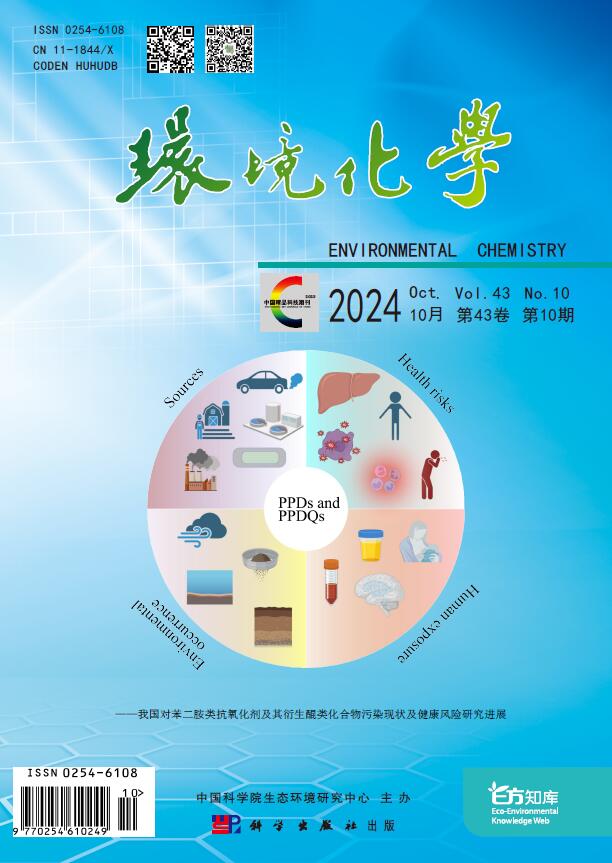


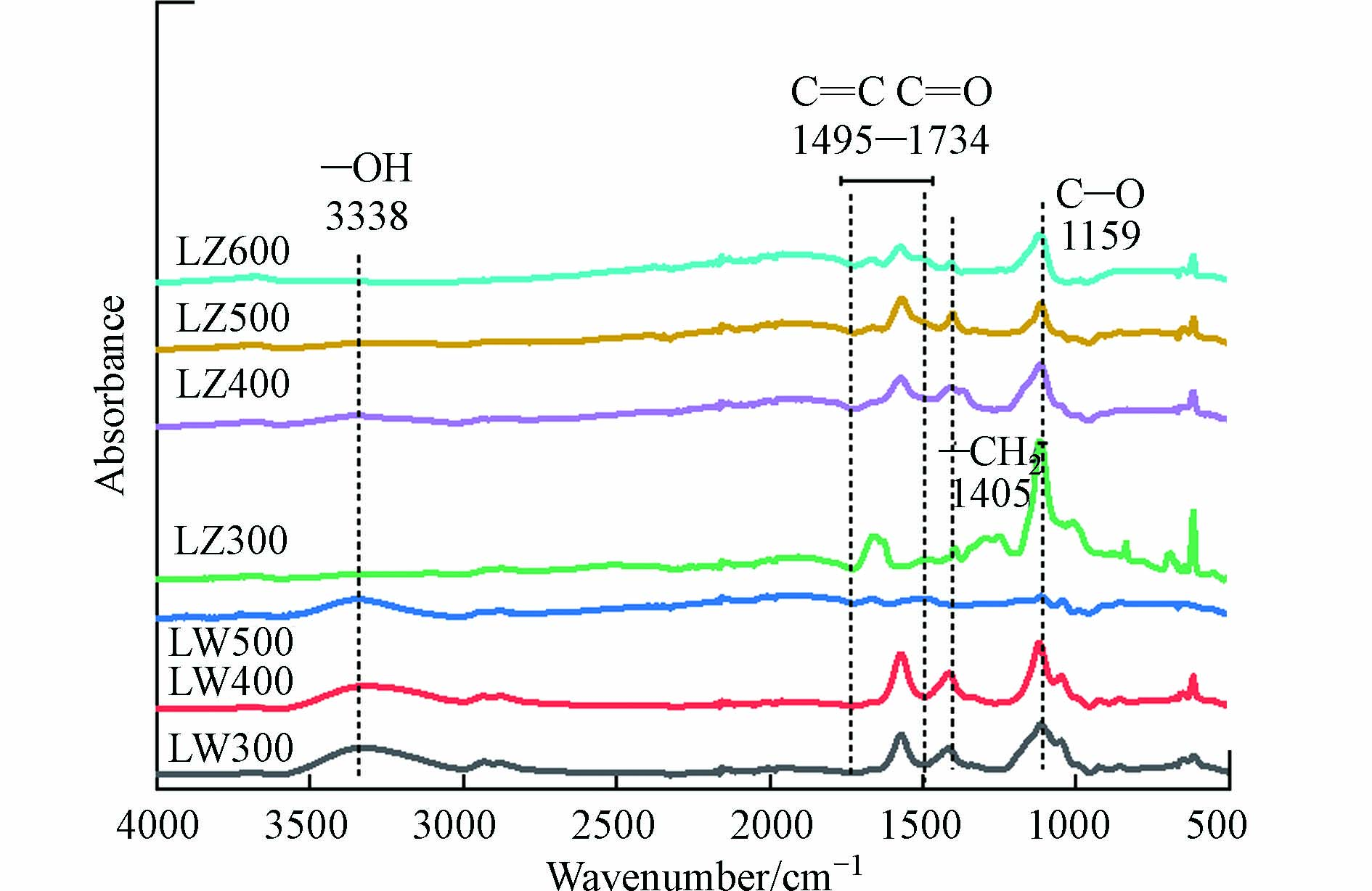

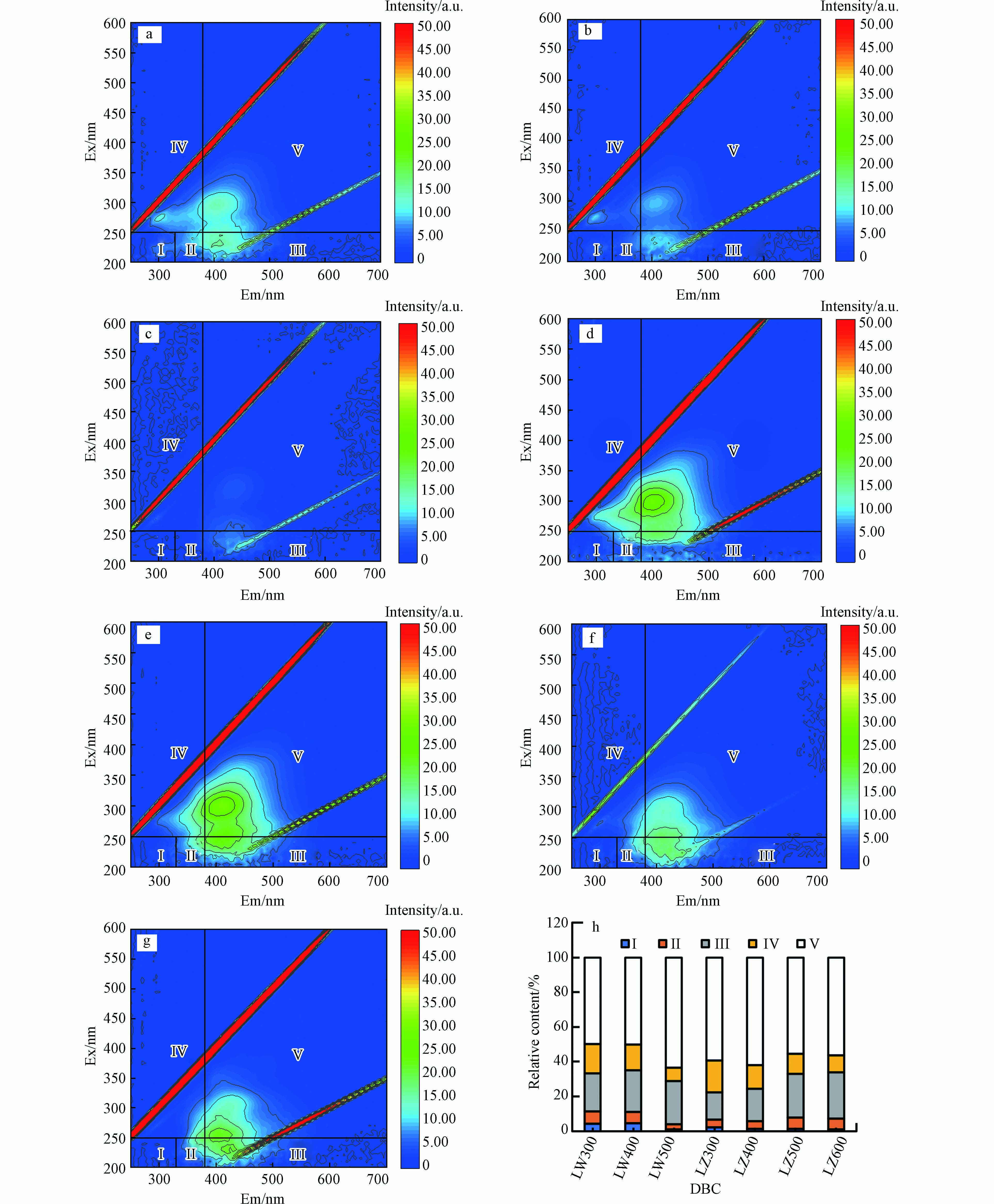

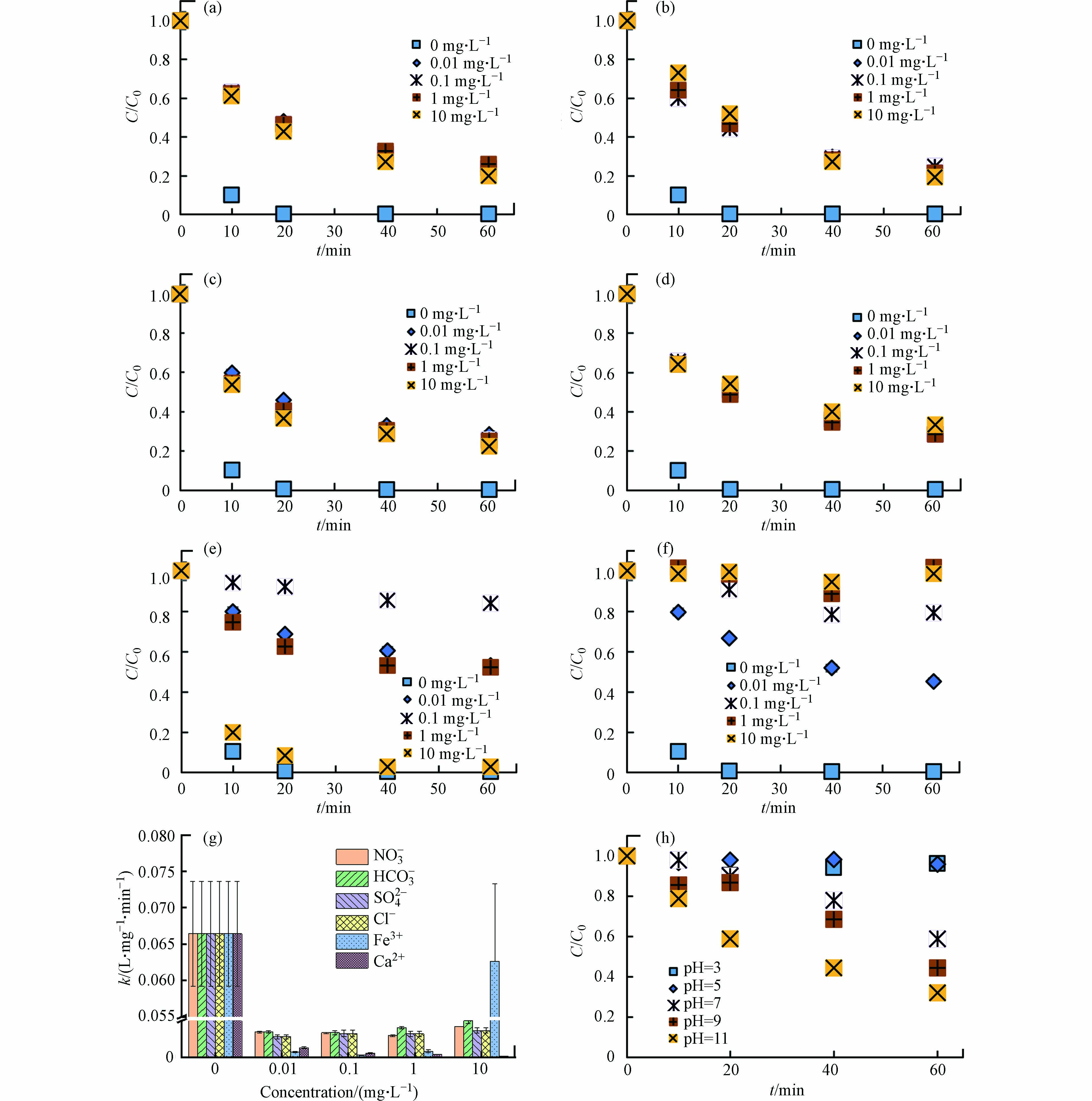
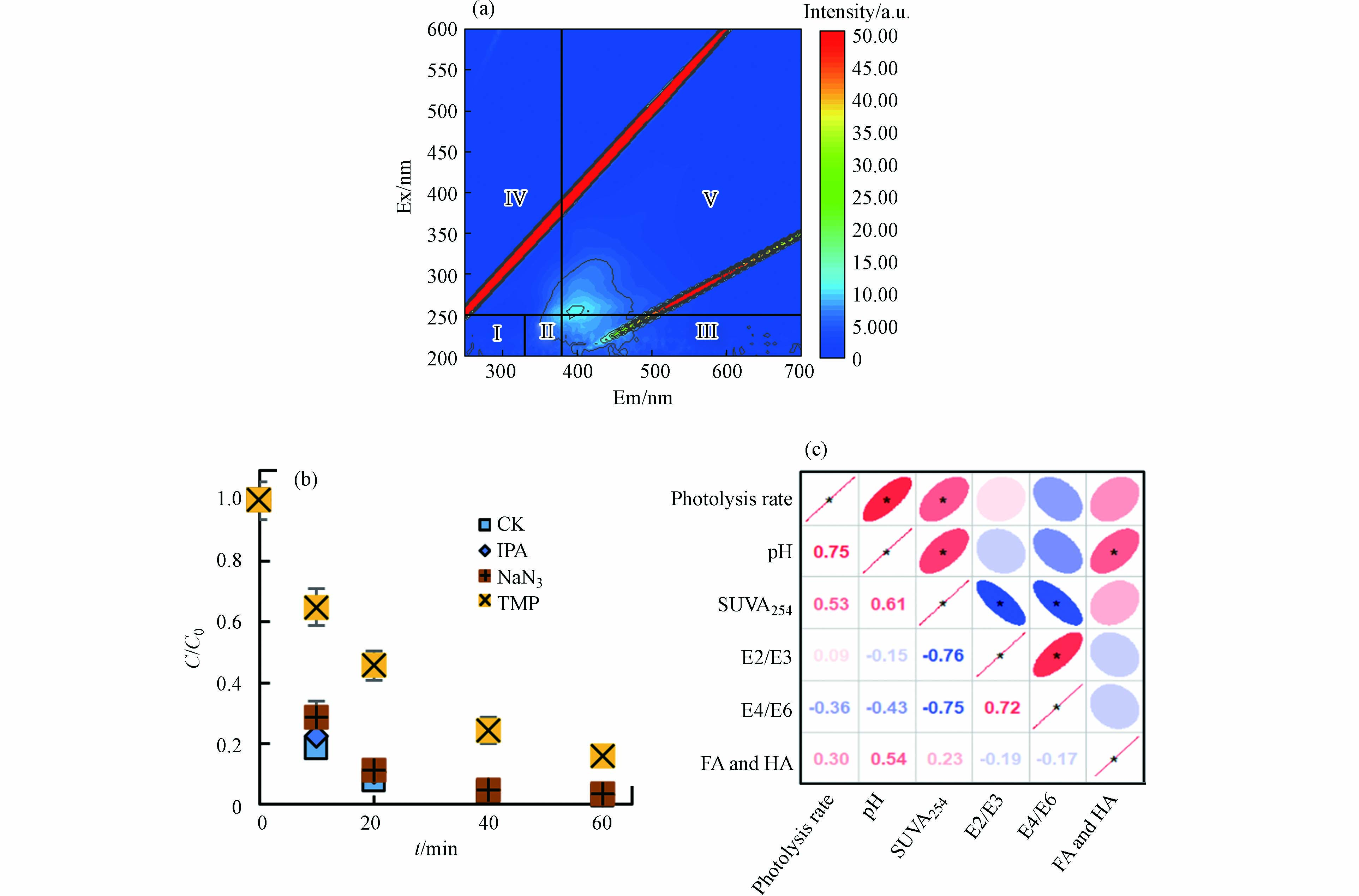
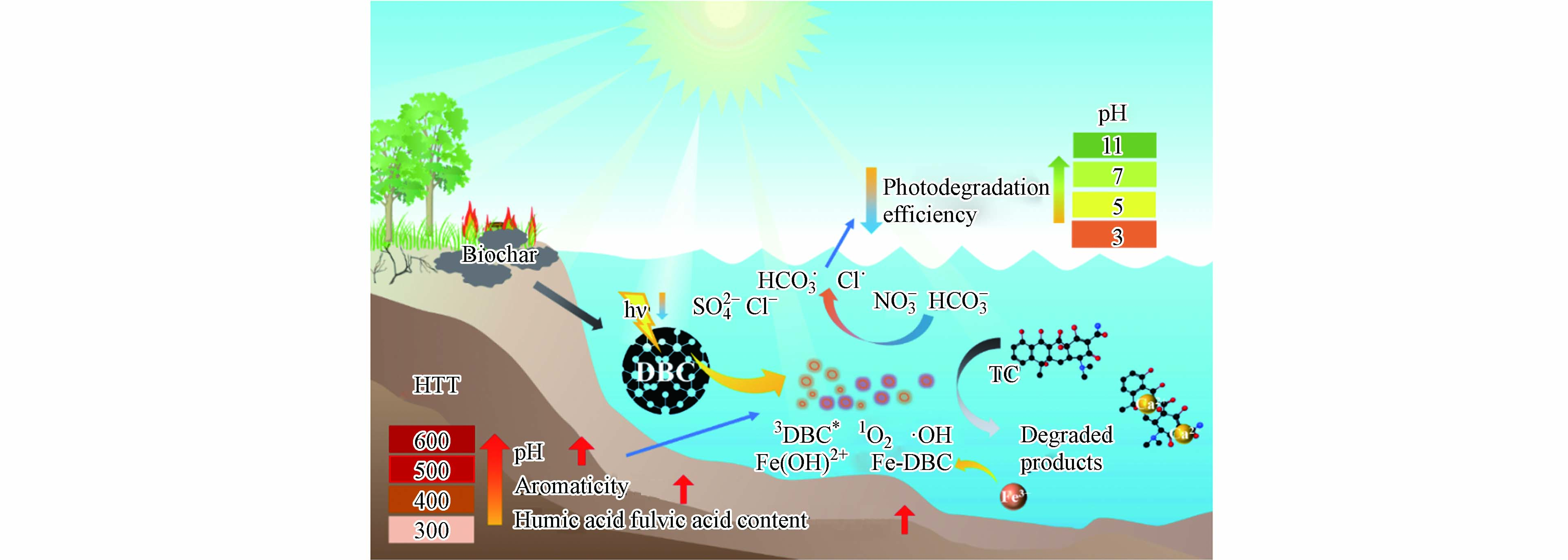
 DownLoad:
DownLoad:
